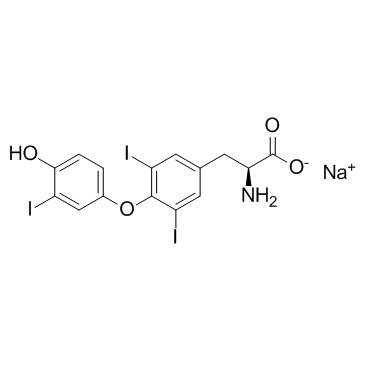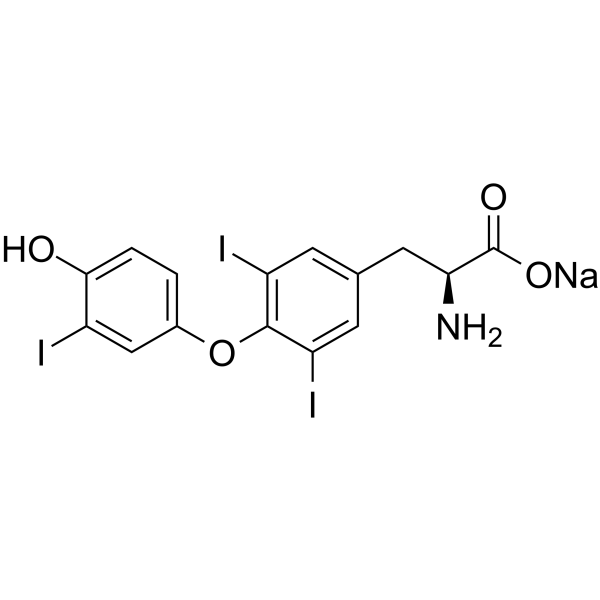3,3',5-三碘-L-甲状腺素钠 ,3,3',5-Triiodo-L-thyronine, sodium salt ,≥98%
产品编号:Bellancom-B414367| CAS NO:55-06-1| 分子式:C15H11I3NNaO4| 分子量:690.9706
3,3',5-Triiodo-L-thyronine sodium 是一种有效的甲状腺激素 (thyroid hormone),可以结合并激活 β1甲状腺激素受体 (TRβ1)。
本网站销售的所有产品仅用于工业应用或者科学研究等非医疗目的,不可用于人类或动物的临床诊断或者治疗,非药用,非食用,
| 产品名称 | 3,3',5-三碘-L-甲状腺素钠 | ||||||||||||||||
|---|---|---|---|---|---|---|---|---|---|---|---|---|---|---|---|---|---|
| 英文名称 | 3,3',5-Triiodo-L-thyronine, sodium salt | ||||||||||||||||
| CAS编号 | 55-06-1 | ||||||||||||||||
| 产品描述 | 3,3',5-Triiodo-L-thyronine sodium 是一种有效的甲状腺激素 (thyroid hormone),可以结合并激活 β1甲状腺激素受体 (TRβ1)。 | ||||||||||||||||
| 产品熔点 | 205 °C (dec.)(lit.) | ||||||||||||||||
| 产品沸点 | 563.5ºC at 760 mmHg | ||||||||||||||||
| 产品闪点 | 294.6ºC | ||||||||||||||||
| 精确质量 | 672.771973 | ||||||||||||||||
| PSA | 95.61000 | ||||||||||||||||
| LogP | 3.31830 | ||||||||||||||||
| 外观性状 | 白色至米色粉末 | ||||||||||||||||
| 溶解性数据 | In Vitro:
0.1 M NaOH : 12.5 mg/mL (18.57 mM; ultrasonic and adjust pH to 11 with NaOH) DMSO : 5.56 mg/mL (8.26 mM; ultrasonic and warming and heat to 60°C) H2O : < 0.1 mg/mL (ultrasonic;warming;heat to 60°C) (insoluble) 配制储备液
*
请根据产品在不同溶剂中的溶解度选择合适的溶剂配制储备液;一旦配成溶液,请分装保存,避免反复冻融造成的产品失效。 In Vivo:
请根据您的实验动物和给药方式选择适当的溶解方案。以下溶解方案都请先按照 In Vitro 方式配制澄清的储备液,再依次添加助溶剂:
——为保证实验结果的可靠性,澄清的储备液可以根据储存条件,适当保存;体内实验的工作液,建议您现用现配,当天使用;
以下溶剂前显示的百
| ||||||||||||||||
| 靶点 |
TRβ1 | ||||||||||||||||
| 体外研究 | 3,3',5-三碘-L-甲状腺素(T3,100nM)刺激TRβ1过表达的肝细胞增殖。 3,3',5-三碘-L-甲状腺素与人β1甲状腺激素受体(hTRβ1)结合,并改变其构象。 3,3',5-三碘-L-甲状腺素促进生长,诱导分化并调节代谢作用。 | ||||||||||||||||
| 细胞实验 | 制备甲状腺激素耗尽(Td)血清。进行甲基纤维素中肝癌细胞的生长。为了确定3,3',5-三碘-L-甲状腺素(T3)对细胞生长的影响,在第0天将细胞以3×104个细胞/ 60mm培养皿的密度接种,并在含有培养基的培养基中培养。 5%常规血清,5%Td或5%Td和100nM T3。初始接种后3周,甲基纤维素中的集落形成评分。 | ||||||||||||||||
| 储存条件 | 本品应密封于0℃以下干燥避光保存。 |
相关文档
化学品安全说明书(MSDS)
下载MSDS质检证书(COA)
相关产品
| 个人防护装备 | Eyeshields;Gloves;type N95 (US);type P1 (EN143) respirator filter |
|---|---|
| 危害码 (欧洲) | Xn: Harmful; |
| 风险声明 (欧洲) | R20/21/22 |
| 安全声明 (欧洲) | S22-S24/25 |
| 危险品运输编码 | NONH for all modes of transport |
| WGK德国 | 3 |
| 海关编码 | 2922509090 |
Synonym:Liothyronine Sodium Section 2 - COMPOSITION, INFORMATION ON INGREDIENTS
Risk Phrases: None Listed. Section 3 - HAZARDS IDENTIFICATION EMERGENCY OVERVIEW
Hygroscopic (absorbs moisture from the air).The toxicological properties of this material have not been fully investigated. Potential Health Effects Eye: May cause eye irritation. Skin: May cause skin irritation. Ingestion: May cause irritation of the digestive tract. The toxicological properties of this substance have not been fully investigated. Inhalation: May cause respiratory tract irritation. The toxicological properties of this substance have not been fully investigated. Chronic: No information found. Section 4 - FIRST AID MEASURES Eyes: Flush eyes with plenty of water for at least 15 minutes, occasionally lifting the upper and lower eyelids. Get medical aid. Skin: Get medical aid. Flush skin with plenty of water for at least 15 minutes while removing contaminated clothing and shoes. Wash clothing before reuse. Ingestion: Never give anything by mouth to an unconscious person. Get medical aid. Do NOT induce vomiting. If conscious and alert, rinse mouth and drink 2-4 cupfuls of milk or water. Inhalation: Remove from exposure and move to fresh air immediately. If not breathing, give artificial respiration. If breathing is difficult, give oxygen. Get medical aid. Notes to Physician: Section 5 - FIRE FIGHTING MEASURES General Information: As in any fire, wear a self-contained breathing apparatus in pressure-demand, MSHA/NIOSH (approved or equivalent), and full protective gear. During a fire, irritating and highly toxic gases may be generated by thermal decomposition or combustion. Runoff from fire control or dilution water may cause pollution. Extinguishing Media: In case of fire, use water, dry chemical, chemical foam, or alcohol-resistant foam. Use agent most appropriate to extinguish fire. Section 6 - ACCIDENTAL RELEASE MEASURES General Information: Use proper personal protective equipment as indicated in Section 8. Spills/Leaks: Vacuum or sweep up material and place into a suitable disposal container. Clean up spills immediately, observing precautions in the Protective Equipment section. Avoid generating dusty conditions. Provide ventilation. Section 7 - HANDLING and STORAGE Handling: Wash thoroughly after handling. Remove contaminated clothing and wash before reuse. Use with adequate ventilation. Minimize dust generation and accumulation. Avoid contact with eyes, skin, and clothing. Keep container tightly closed. Avoid ingestion and inhalation. Storage: Keep container closed when not in use. Store in a tightly closed container. Store in a cool, dry, well-ventilated area away from incompatible substances. Hormones and antibiotics room. Store protected from moisture. Section 8 - EXPOSURE CONTROLS, PERSONAL PROTECTION Engineering Controls: Facilities storing or utilizing this material should be equipped with an eyewash facility and a safety shower. Use adequate ventilation to keep airborne concentrations low. Exposure Limits CAS# 55-06-1: Personal Protective Equipment Eyes: Wear appropriate protective eyeglasses or chemical safety goggles as described by OSHA's eye and face protection regulations in 29 CFR 1910.133 or European Standard EN166. Skin: Wear appropriate protective gloves to prevent skin exposure. Clothing: Wear appropriate protective clothing to minimize contact with skin. Respirators: Follow the OSHA respirator regulations found in 29 CFR 1910.134 or European Standard EN 149. Use a NIOSH/MSHA or European Standard EN 149 approved respirator if exposure limits are exceeded or if irritation or other symptoms are experienced. Section 9 - PHYSICAL AND CHEMICAL PROPERTIES Physical State: Powder Color: beige Odor: None reported. pH: Not available. Vapor Pressure: Not available. Viscosity: Not available. Boiling Point: Not available. Freezing/Melting Point: 205 deg C Autoignition Temperature: Not applicable. Flash Point: Not applicable. Explosion Limits, lower: Not available. Explosion Limits, upper: Not available. Decomposition Temperature: Solubility in water: Specific Gravity/Density: Molecular Formula: C15H11I3NO4Na Molecular Weight: 672.96 Section 10 - STABILITY AND REACTIVITY Chemical Stability: Stable under normal temperatures and pressures. Conditions to Avoid: Incompatible materials, dust generation, excess heat, strong oxidants, exposure to moist air or water. Incompatibilities with Other Materials: Moisture, oxidizing agents. Hazardous Decomposition Products: Nitrogen oxides, carbon monoxide, irritating and toxic fumes and gases, carbon dioxide, nitrogen, hydrogen iodide. Hazardous Polymerization: Has not been reported. Section 11 - TOXICOLOGICAL INFORMATION RTECS#: CAS# 55-06-1: YP2836500 LD50/LC50: Not available. Carcinogenicity: 3,3',5- Triiodo-L-Thyronine, Sodium Salt - Not listed by ACGIH, IARC, or NTP. Other: See actual entry in RTECS for complete information. Section 12 - ECOLOGICAL INFORMATION Section 13 - DISPOSAL CONSIDERATIONS Dispose of in a manner consistent with federal, state, and local regulations. Section 14 - TRANSPORT INFORMATION IATA Not regulated as a hazardous material. IMO Not regulated as a hazardous material. RID/ADR Not regulated as a hazardous material. Section 15 - REGULATORY INFORMATION European/International Regulations European Labeling in Accordance with EC Directives Hazard Symbols: Not available. Risk Phrases: Safety Phrases: S 24/25 Avoid contact with skin and eyes. S 28A After contact with skin, wash immediately with plenty of water. S 37 Wear suitable gloves. S 45 In case of accident or if you feel unwell, seek medical advice immediately (show the label where possible). WGK (Water Danger/Protection) CAS# 55-06-1: No information available. Canada None of the chemicals in this product are listed on the DSL/NDSL list. CAS# 55-06-1 is not listed on Canada's Ingredient Disclosure List. US FEDERAL TSCA CAS# 55-06-1 is not listed on the TSCA inventory. It is for research and development use only. SECTION 16 - ADDITIONAL INFORMATION N/A |










 浙公网安备 33010802013016号
浙公网安备 33010802013016号